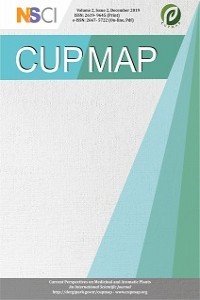In-vitro comparison release study of novel liposome and conventional formulation containing Rosmarinus officinalis extract
In-vitro comparison release study of novel liposome and conventional formulation containing Rosmarinus officinalis extract
Phytochemicals, Herbal liposomes, Rosmarinus officinalis In-vitro release, Franz diffusion cell,
___
- Aslan, I. (2007) Plants and Cosmetics. Fitomed, 3, 49-51.
- Drew, Bryan T.; González-Gallegos, Jesús Guadalupe; Xiang, Chun-Lei; Kriebel, Ricardo; Drummond, Chloe P.; Walker, Jay B.; Sytsma, Kenneth J. (2017). "Salvia united: The greatest good for the greatest number". Taxon. 66(1): 133–145.
- Dawn C P Ambrose,(2016), Leafy Medicinal Herbs: Botany, Chemistry, Postharvest Technology and Uses by Dawn Ambrose, 216, 210-11
- Madison D. (2017)The Illustrated Encyclopedia of Fruits, Vegetables, and Herbs: History, Botany by Deborah Madison, p.266
- Centre for Agriculture and Bioscience International.,(2018), "Rosmarinus officinalis (rosemary)".
- Database USDA Nutrient, (2014),"Nutrition Facts – Dried rosemary, one teaspoon (1 g)". nutritiondata.com. Conde Nast, , version SR-21.
- Daniells, Stephen (2017). "Oregano, rosemary extracts promise omega-3 preservation". Food Navigator.
- Vallverdú-Queralt, Anna; Regueiro, Jorge; Martínez-Huélamo, Miriam; Rinaldi Alvarenga, José Fernando; Leal, Leonel Neto; Lamuela-Raventos, Rosa M. (2014).
- "A comprehensive study on the phenolic profile of widely used culinary herbs and spices: Rosemary, thyme, oregano, cinnamon, cumin and bay". Food Chemistry. 154: 299–307.
- Biju SS, Talegaonkar S, Mishra PR, Khar RK. (2006) Vesicular system: an overview. Indian J Pharm Sci.; 68(2): 141-153.
- Atmakuri LR, Dathi S. (2010), Current trends in herbal medicines. J Pharm Res.; 3(1):109-113.
- Aslan, İ , Kurt, A . (2020). Characterization and Optimization of Phytosome Formulation Containing Alcohol-free Umckalin from Pelargonium sidoides . Current Perspectives on Medicinal and Aromatic Plants (CUPMAP) , 3 (1) , 49-53 . DOI: 10.38093/cupmap.737878
- Duman, G., Aslan, İ., Özer, A. Y., İnanç, İ., Taralp, A. (2014). Liposome, gel and lipogelosome formulations containing sodium hyaluronate. Journal of liposome research, 24(4), 259–269. https://doi.org/10.3109/08982104.2014.907305.
- Ethemoglu, M. S., Seker, F. B., Akkaya, H., Kilic, E., Aslan, I., Erdogan, C. S., Yilmaz, B. (2017). Anticonvulsant activity of resveratrol-loaded liposomes in vivo. Neuroscience, 357, 12–19. https://doi.org/10.1016/j.neuroscience.2017.05.026.
- Gunal, M. Y., Ayla, Ş., Bedri, N., Beker, M. Ç., Çağlayan, A. B., Aslan, İ. ... Kılıç, Ü. (2019). The effects of topical liposomal resveratrol on incisional and excisional wound healing process. Turkderm-Turkish Archives of Dermatology and Venerology, 53(4), 128-134. http://doi.org/10.4274/turkderm.galenos.2019.82612.
- Yazici, M., Duman, G., Aslan, I., Durucan, A., & Sahin, F. (2011). The antifungal activity of liposomal ointment formulation of essential oil of Satureja hortensis. Current Opinion in Biotechnology, (22), S108. http://doi.org/10.1016/j.copbio.2011.05.345
- Uhumwangho MU, Okor RS. 2005 Current trends in the production and biomedical applications of liposomes: a review. J Biomed Sci.; 4: 9-21. http://doi.org/10.4314/jmbr.v4i1.10663
- Yadav D, Suri S, Choudhary AA, Sikender M, Hemant, Beg NM, et al. (2011), Novel approach: Herbal remedies and natural products in pharmaceutical science as nano drug delivery systems. Int J Pharm Tech.;3:3092-116.
- Rong G, JuQun X. (2007) Studies on molecular interection between puerarin and PC liposomes. Chinese Sci Bull.;52:2612-7
- Chen J, Chen Z, Wang W. (2010), Ammonium sulphate gradient loading of brucine into liposome: effect of phospholipid composition on entrapment efficiency and physicochemical properties in vitro. Drug Dev Ind Pharm.;36:245-253.
- Gortzi O, Lalas S, Chinou L. (2008), Re-evaluation of bioactivity and antioxidant activity of myrtuscommunis extract before and after encapsulation in liposome. Eur Food Res Technol.;226:583-90
- Hazra B, Kumar B, Biswas S, Pandey BN, Mishra KP. (2005) Enhancement of the tumour inhibitory activity, in vivo, of diospyrin, a plantderived quinonoid, through liposomal encapsulation. Toxicol Lett.;157:109-17
- Fadda AM, Sinico C, Lai F, Logu AD. (2005), Liposomal incorporation of artimisia arborescenceL. Essential oil and in vitro antiviral activity. Eur J Pharma Biopharma.;59:161-8.
- Ghosh D, Ghosh S, Sarkar S, Ghosh A, Das N, Das Saha K, et al. (2010) Quercetin in vesicular delivery systems: evaluation in combating arsenic-induced acute liver toxicity associated gene expression in rat model. Chem Biol Interact.;186:61-71.
- Chen C. (2008), Inhibiting the vascular smooth muscle cells proliferation By EPC and DPPC liposome encapsulated magnalol. J Chin Inst Chem Eng.;39:407-411.
- Ng, SF., Rouse, J.J., Sanderson, F.D. et al. Validation of a Static Franz Diffusion Cell System for In Vitro Permeation Studies. AAPS PharmSciTech 11, 1432–1441 (2010). https://doi.org/10.1208/s12249-010-9522-9
- ISSN: 2619-9645
- Yayın Aralığı: Yılda 2 Sayı
- Başlangıç: 2018
- Yayıncı: Nazım ŞEKEROĞLU
Antimicrobial, antibiofilm-forming properties of Equisetum arvense L. shoot extracts
Assoc. Prof. Marina KRYVTSOVA, Jana KOŠČOVÁ, Tanya KOHUCH, Marianna SAVENKO, Nokolay SPIVAK
Zehra GÖKÇE, Ökkeş YILMAZ, Hatayi ZENGİN
Fidelis OKOLAFOR, Frederick EKHAISE
Rishiram BARAL, Amrit KARKI, Saurav KARKI, Bhuvan NEUPANE, Pratigya KOIRALA, Seema BARAL, Sushil PANTA
